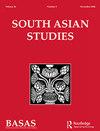{"title":"Krishna’s lineage. The Harivamsha of Vyāsa’s Mahābhārata","authors":"D. Feller","doi":"10.1080/02666030.2021.1935476","DOIUrl":null,"url":null,"abstract":"examples of Indian miniature painting, sculpture and textiles are anonymous this argument does not convince. Their absence from museum collections is more likely to be because they were made as domestic objects by non-professional women, and were thus much less likely to come to the attention of the (mostly male) museum curators of the time. The core of the book takes two historic kanthas, one in the Gurusaday Museum in Kolkata and one in the Philadelphia Museum of Art, as case studies around which to build many-stranded narratives of aspects of life in colonial Bengal in the 19 and early 20 century. The two kanthas are well-chosen: both (unusually) have embroidered inscriptions giving the name of the maker and an indication of why they were made – one as a gift to the maker’s father, and the other in praise of Radha and Krishna. The two kanthas are visually very different, although the styles in which their motifs are depicted are not part of the discussion. One of the kanthas bears mostly secular motifs, while the other illustrates stories of Radha and Krishna. The scenes depicted on the two kanthas are starting points from which the author skilfully explores subjects such as female literacy in Bengal, the place of women in the nationalist movement, the status of widows, the evolution of the Bengali babu and his depictions, domestic violence, public transport, the role of attendants and servants, dance and dancers, Hindu travelling gosains, Kalighat paintings and Battala prints, Bengali coinage, satirical depictions of dandies, brahmins and weakwilled men, and iconographies of the lotus, pleasureboat rides and composite animals. The book approaches kantha mainly through ethnographic, literary and archival sources rather than from the viewpoint of art history; as a result, it is sparsely illustrated compared with other books on kantha embroidery. The copious endnotes give details of comparative pieces, but more illustrations of such pieces would have been welcome. Illustrations of Kalighat paintings, popular prints and terracotta temple carvings make their points succinctly. At times the language tends to academic jargon and the sentences to longwindedness. Given the breadth of the discussion of life in colonial Bengal, I was surprised to see no mention of the Baluchar sari, a contemporary of the kantha that also uses human figures (and steam trains) in its iconography, albeit made by professional male weavers in urban settings. While I found the sections on the modern-day kantha over-long, the exploration of the hinterland of the two featured pieces is full of interest. The detailed analysis of the images on the kanthas and the interpretations that the author suggests for them not only make us look more closely at the pieces themselves but also invite us to reflect more broadly on what life was like for a woman in 19 and early 20-century Bengal. Rosemary Crill Former Senior Curator, Victoria and Albert Museum rosemarycrill@gmail.com © 2021, Rosemary Crill https://doi.org/10.1080/02666030.2021.1893021","PeriodicalId":52006,"journal":{"name":"South Asian Studies","volume":"2 1","pages":"74 - 76"},"PeriodicalIF":0.5000,"publicationDate":"2021-01-02","publicationTypes":"Journal Article","fieldsOfStudy":null,"isOpenAccess":false,"openAccessPdf":"","citationCount":"2","resultStr":null,"platform":"Semanticscholar","paperid":null,"PeriodicalName":"South Asian Studies","FirstCategoryId":"1095","ListUrlMain":"https://doi.org/10.1080/02666030.2021.1935476","RegionNum":0,"RegionCategory":null,"ArticlePicture":[],"TitleCN":null,"AbstractTextCN":null,"PMCID":null,"EPubDate":"","PubModel":"","JCR":"0","JCRName":"ASIAN STUDIES","Score":null,"Total":0}
引用次数: 2
Krishna’s lineage. The Harivamsha of Vyāsa’s Mahābhārata
examples of Indian miniature painting, sculpture and textiles are anonymous this argument does not convince. Their absence from museum collections is more likely to be because they were made as domestic objects by non-professional women, and were thus much less likely to come to the attention of the (mostly male) museum curators of the time. The core of the book takes two historic kanthas, one in the Gurusaday Museum in Kolkata and one in the Philadelphia Museum of Art, as case studies around which to build many-stranded narratives of aspects of life in colonial Bengal in the 19 and early 20 century. The two kanthas are well-chosen: both (unusually) have embroidered inscriptions giving the name of the maker and an indication of why they were made – one as a gift to the maker’s father, and the other in praise of Radha and Krishna. The two kanthas are visually very different, although the styles in which their motifs are depicted are not part of the discussion. One of the kanthas bears mostly secular motifs, while the other illustrates stories of Radha and Krishna. The scenes depicted on the two kanthas are starting points from which the author skilfully explores subjects such as female literacy in Bengal, the place of women in the nationalist movement, the status of widows, the evolution of the Bengali babu and his depictions, domestic violence, public transport, the role of attendants and servants, dance and dancers, Hindu travelling gosains, Kalighat paintings and Battala prints, Bengali coinage, satirical depictions of dandies, brahmins and weakwilled men, and iconographies of the lotus, pleasureboat rides and composite animals. The book approaches kantha mainly through ethnographic, literary and archival sources rather than from the viewpoint of art history; as a result, it is sparsely illustrated compared with other books on kantha embroidery. The copious endnotes give details of comparative pieces, but more illustrations of such pieces would have been welcome. Illustrations of Kalighat paintings, popular prints and terracotta temple carvings make their points succinctly. At times the language tends to academic jargon and the sentences to longwindedness. Given the breadth of the discussion of life in colonial Bengal, I was surprised to see no mention of the Baluchar sari, a contemporary of the kantha that also uses human figures (and steam trains) in its iconography, albeit made by professional male weavers in urban settings. While I found the sections on the modern-day kantha over-long, the exploration of the hinterland of the two featured pieces is full of interest. The detailed analysis of the images on the kanthas and the interpretations that the author suggests for them not only make us look more closely at the pieces themselves but also invite us to reflect more broadly on what life was like for a woman in 19 and early 20-century Bengal. Rosemary Crill Former Senior Curator, Victoria and Albert Museum rosemarycrill@gmail.com © 2021, Rosemary Crill https://doi.org/10.1080/02666030.2021.1893021


